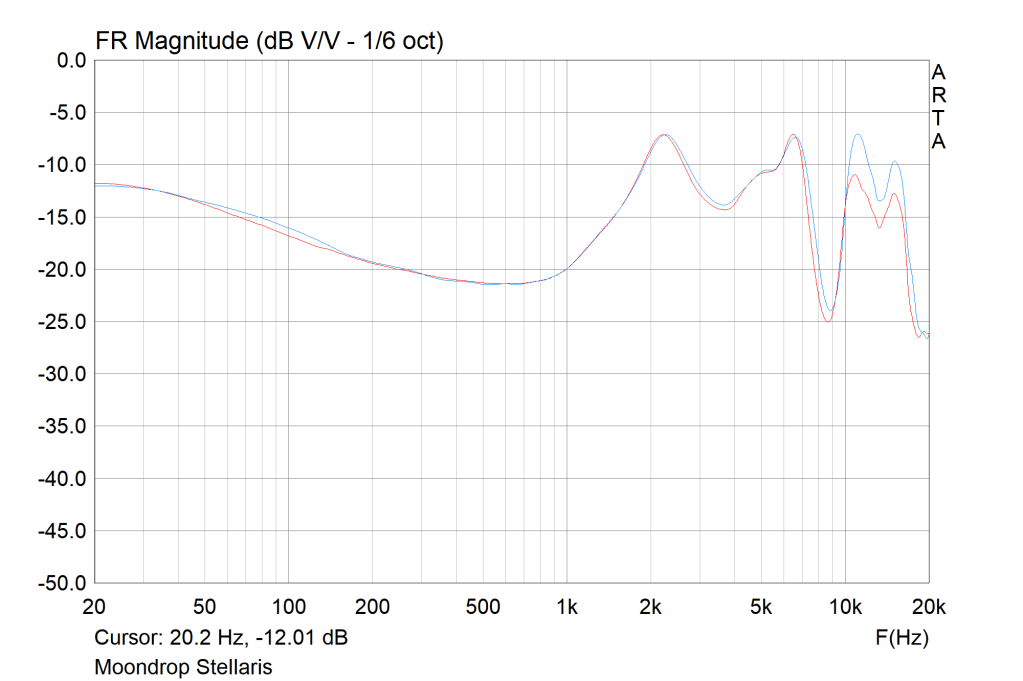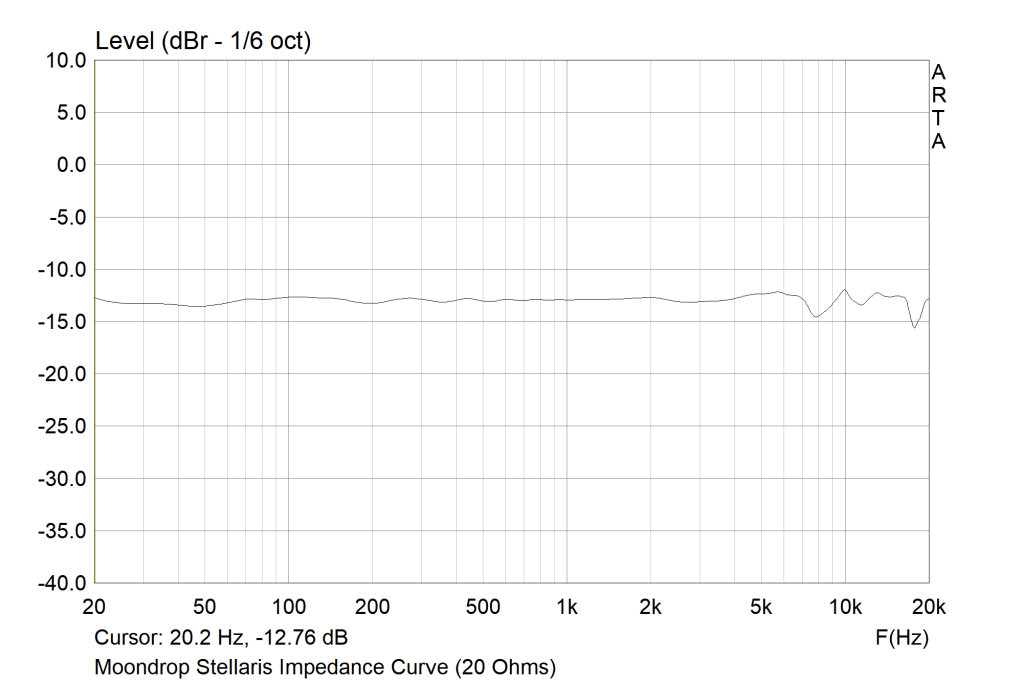Sound –

Testing Methodology: Measured using Arta via IEC 711 coupler to Startech external sound card. 7-9KHz peaks may be artefacts/emphasised due to my measurement setup which I found to be the case here. Measurements besides channel balance are volume matched at 1KHz. Fit depth normalised to my best abilities to reduce coupler resonance. Still, due to these factors, my measurements may not accurately reflect the earphone or measurements taken by others. I gave the Stellaris 100hrs burn-in to ensure maximum performance prior to subjective breakdown.
Tonality –
Moondrop touts that the Stellaris abides by their highly regarded VDSF tuning curve, and this was the main reason for the hype surrounding this model. To date, planar in-ears have made huge progress, now offering excellent technical performance at a low cost. However, the tuning has left to be desired on these models usually peaking too early in the midrange and struggling with an uneven treble response. Audeze has somewhat tackled this issue with the Euclid yet at a far more substantial cost. It appears the rest of the more budget-minded planar in-ears are stuck with the same or a very similar driver given the persistent struggle with these same issues. Unfortunately, the Stellaris is not the solution many of us were hoping for, especially not for those expect a similar tuning to their dynamic models. While the Stellaris offers a decent tonal balance in summary, it still suffers from the same pitfalls as its competitors such as the 7Hz Dioko and Shuoer S12. Ironically for the company, while the Stellaris offers slightly better resolving power than similarly priced planar in-ears, its tonal balance is actually slightly worse.
Bass –
The low end is altogether quite lean but technically capable. Moondrop has imbued this model with a downwards sloping tuning that notably extends quite linearly into the sub-bass region. As a result, it delivers an affirmative sub-bass alongside a clean mid-bass and slightly leaner upper-bass to lower-midrange transition. This lends the earphone an overall thinner and cooler character whilst serving to maximise separation. Bass overall sits behind the mids and highs but not to the extent that it is ever over shadowed. Notes offer neutral body overall with a smidgeon of additional sub-bass slam offering good impact and an ample sense of weight and presence overall.
Besides the clean tuning, the chief attribute that really impressed me was the earphone’s PRAT. The Stellaris excels with a particularly tight, concise note delivery that contributes to excellent snap and rhythm. Bass is tight and fast, offering a defined attack and swift decay. In so doing, separation is excellent, and notes are also impressively well-textured. Overall low-end resolving power performs at a much higher level than the asking price might suggest. I have heard greater punch and weight and more natural note decay. However, the Stellaris’ agile and responsive low-end makes it engaging despite bass never really standing out in terms of emphasis in the sound signature.
Mids –
As seen on the frequency response graph, the Stellaris peaks just after 2kHz before somewhat falling off, picking up again as it enters the lower-treble. Where I am usually a fan of a slightly lower treble emphasis, the Stellaris takes the magnitude a few notches too far to my ears, resulting in an image that lacks some coherence. It isn’t overly intense but certainly vocal-forward. The cool tone and lack of warmth or body in the bass to lower-midrange regions contribute to noticeably off-timbre vocals. The Stellaris sounds raspy and at times even metallic as a result. Unfortunately, the treble tuning doesn’t aid its case. The lower-treble emphasis increases articulation which only contributes to breathier, daintier vocals and high-frequency biased instruments.

The Stellaris therefore lacks the sense of room and scale that more balanced in-ears achieve. The Shuoer S12 is a good comparison as it has a very similar overall sound profile. The chief difference lies in a slightly warmer bass and less prominent upper midrange. This lends it a presentation that is lean but on the periphery of what I would consider natural sounding. The Stellaris pushes this leanness a bit too far, reducing its genre versatility. On the contrary, some may enjoy the clarity and separation on offer, even if coherence and timbre leave to be desired. The same aforementioned technical chops remain on offer albeit the tonality does make this difficult to appreciate within the midrange.
Highs –
The top-end is defined by a moderate lower-treble peak and then later upper-treble emphasis. I don’t personally find upper-treble emphasis to be too offensive and know that many enjoy the sense of sparkle and atmosphere it imbues – this is also the case here. Moreover, while the midrange pushes somewhat bright and I also acknowledge the treble to be bright, to me it is in a less polarising manner. A deeper fit does help here and is easily achieved with the Stellaris’ elongated design. There is a main caveat which is once again note body. The lower treble peak instigates this issue, sharpening the presentation and providing more bite to percussion and the general leading edge of notes. The rapid transient response aids this impression.
Adding to the problem is the addition of the upper-treble boost provides an even thinner, daintier note body. Treble sounds light and near brittle but is technically accomplished all the same. Micro details are brought to the fore and fine detail separation is excellent. If you want a rich, natural instrument presentation, this won’t be the earphone for you. The Stellaris provides large amounts of air and atmosphere alongside highlighting the minutiae. It has the resolution to provide a rather complex image too, something you don’t commonly see in this price range. If you can stomach the relative overall brightness on display or don’t mind sacrificing a bit of resolution with foam tips to quell it, the Stellaris offers a strong level of extension and detail at the price.
Soundstage –
The Stellaris provides a moderately expanded soundstage with a good amount of atmosphere but falls short of higher end IEMs on raw space. Width takes a bias over depth, especially due to the intimate vocal presentation. Imaging is a sharp performer that said, with a clean transient response and crispy tuning that highlights directional cues. What the Stellaris lacks is multi-faceted layering as the earphone lacks the background cleanliness of many competitors due to its brightness and lacks room. This means its stage doesn’t quite have a natural sense of scale and foreground/background separation. Speaking of which, separation performs at a generally high level due to the agile driver and lean tuning just at the expense of sounding a bit sparse at times.
Driveability –
Output Impedance Sensitivity

Like many planar designs, the Stellaris has an essentially flat impedance curve meaning it will deliver a consistent sound profile from linear sources regardless of output impedance. My measurements confirmed my subjective testing as, from a 20 Ohm source, the frequency response is broadly identical. This makes the Stellaris a good choice for those desiring a consistent sound profile from multiple sources.
Driving Power
Don’t let the large driver fool you, the Stellaris is very efficient with a high 117dB sensitivity and a medium 36 Ohm impedance. This means it isn’t too demanding of current but still deliver high listening volumes from lower powered sources making it a great companion for daily users listening from dongles and other portable sources. While my desktop stack did provide a good jump in dynamics and slam, I didn’t experience too much compression or loss to soundstage expansion from my better dongles such as the Hidizs S9 Pro.
Suggested Pair Ups
Naturally, the Stellaris pairs better with warmer sources that provide a bit more body and density to its sound. These include sources like the AK Dual DAC dongle and really most AKM-based sources that tend to be a bit more forgiving. A neutral source isn’t a bad pairing but listeners are best to avoid brighter sources as they will only further exacerbate issues with timbre and sharpness. Power requirements are minimal and a higher output impedance isn’t an impediment to a balanced sound meaning the Stellaris is overall, an easy earphone to drive albeit picky with regards to source tonality.



